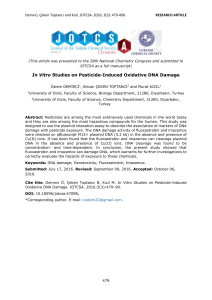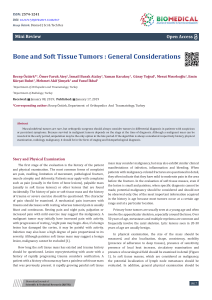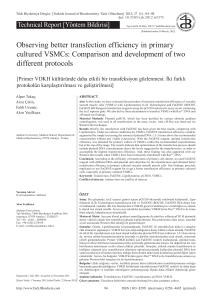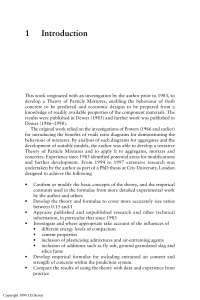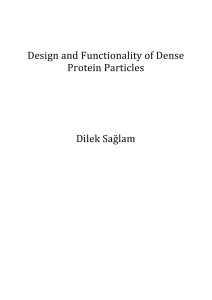Uploaded by
common.user3699
Copper Leaching Kinetic Study in Electroplating Waste Sludge
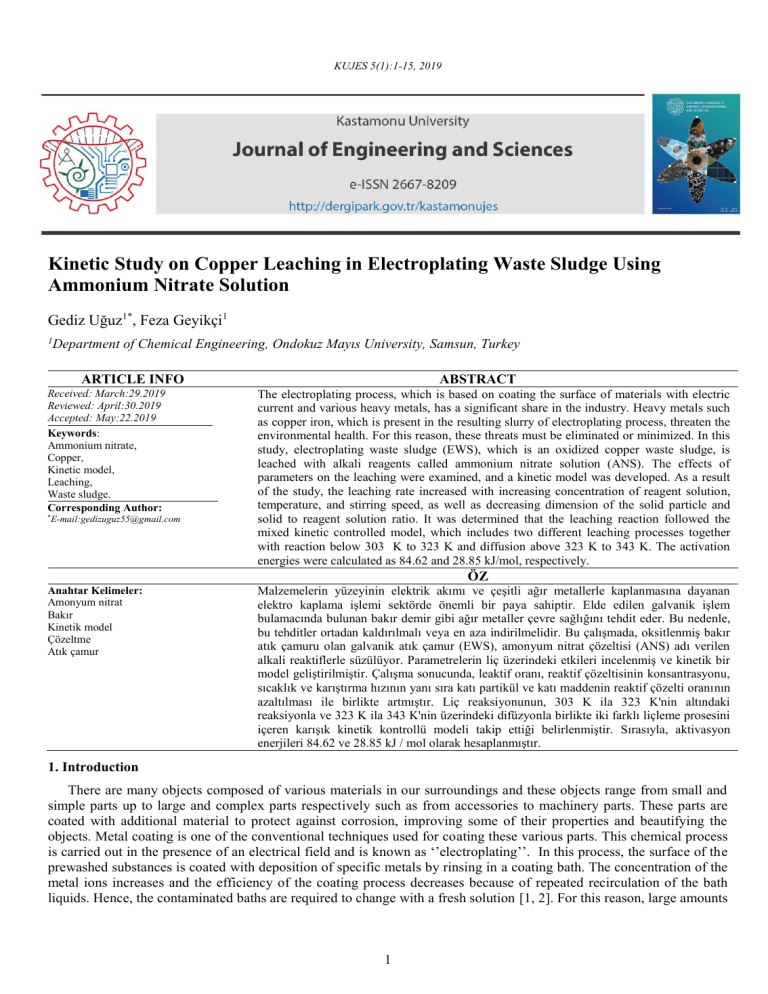
KUJES 5(1):1-15, 2019 Kinetic Study on Copper Leaching in Electroplating Waste Sludge Using Ammonium Nitrate Solution Gediz Uğuz1*, Feza Geyikçi1 Department of Chemical Engineering, Ondokuz Mayıs University, Samsun, Turkey 1 ARTICLE INFO Received: March:29.2019 Reviewed: April:30.2019 Accepted: May:22.2019 Keywords: Ammonium nitrate, Copper, Kinetic model, Leaching, Waste sludge. Corresponding Author: * E-mail:[email protected] ABSTRACT The electroplating process, which is based on coating the surface of materials with electric current and various heavy metals, has a significant share in the industry. Heavy metals such as copper iron, which is present in the resulting slurry of electroplating process, threaten the environmental health. For this reason, these threats must be eliminated or minimized. In this study, electroplating waste sludge (EWS), which is an oxidized copper waste sludge, is leached with alkali reagents called ammonium nitrate solution (ANS). The effects of parameters on the leaching were examined, and a kinetic model was developed. As a result of the study, the leaching rate increased with increasing concentration of reagent solution, temperature, and stirring speed, as well as decreasing dimension of the solid particle and solid to reagent solution ratio. It was determined that the leaching reaction followed the mixed kinetic controlled model, which includes two different leaching processes together with reaction below 303 K to 323 K and diffusion above 323 K to 343 K. The activation energies were calculated as 84.62 and 28.85 kJ/mol, respectively. ÖZ Anahtar Kelimeler: Amonyum nitrat Bakır Kinetik model Çözeltme Atık çamur Malzemelerin yüzeyinin elektrik akımı ve çeşitli ağır metallerle kaplanmasına dayanan elektro kaplama işlemi sektörde önemli bir paya sahiptir. Elde edilen galvanik işlem bulamacında bulunan bakır demir gibi ağır metaller çevre sağlığını tehdit eder. Bu nedenle, bu tehditler ortadan kaldırılmalı veya en aza indirilmelidir. Bu çalışmada, oksitlenmiş bakır atık çamuru olan galvanik atık çamur (EWS), amonyum nitrat çözeltisi (ANS) adı verilen alkali reaktiflerle süzülüyor. Parametrelerin liç üzerindeki etkileri incelenmiş ve kinetik bir model geliştirilmiştir. Çalışma sonucunda, leaktif oranı, reaktif çözeltisinin konsantrasyonu, sıcaklık ve karıştırma hızının yanı sıra katı partikül ve katı maddenin reaktif çözelti oranının azaltılması ile birlikte artmıştır. Liç reaksiyonunun, 303 K ila 323 K'nin altındaki reaksiyonla ve 323 K ila 343 K'nin üzerindeki difüzyonla birlikte iki farklı liçleme prosesini içeren karışık kinetik kontrollü modeli takip ettiği belirlenmiştir. Sırasıyla, aktivasyon enerjileri 84.62 ve 28.85 kJ / mol olarak hesaplanmıştır. 1. Introduction There are many objects composed of various materials in our surroundings and these objects range from small and simple parts up to large and complex parts respectively such as from accessories to machinery parts. These parts are coated with additional material to protect against corrosion, improving some of their properties and beautifying the objects. Metal coating is one of the conventional techniques used for coating these various parts. This chemical process is carried out in the presence of an electrical field and is known as ‘’electroplating’’. In this process, the surface of the prewashed substances is coated with deposition of specific metals by rinsing in a coating bath. The concentration of the metal ions increases and the efficiency of the coating process decreases because of repeated recirculation of the bath liquids. Hence, the contaminated baths are required to change with a fresh solution [1, 2]. For this reason, large amounts 1 Uğuz and Geyikçi, 5(1):1-15, 2019 of liquid waste is generated called wastewater after this chemical process. These wastewaters contain harmful and toxic subtances such as heavy metals [3]. With the treatment of the wastewater, a large amount of waste sludge is produced and this valuable sludge is called EWS that is a complex mixture and hazardous solid waste, containing various heavy metals (Cu, Cr, Zn, Ni, Fe). In this respect, it is referred to be a potential valuable resource. For humans, exposure to these heavy metals can cause various diseases such as cancer, hypertension and renal dysfunction. These valuable heavy metals can be effectively cleared from the sludge with certain methods, then the filtered sludge and the remaining heavy metals can be reused. It has importance that the to perform economic recycling and recovery of heavy metals from the sludge to the highest level, in order to have sustainable development, which emphasizes both the preservation of the environment and with the reusable resources. In recent years, there are many techniques which have been developed for the recycling and reusability of heavy metals. Leaching, electrolysis, solvent extraction, membrane separation, ion exchange, and microbiological methods are among such these methods. In industrial practices these traditional methods are limited to such factors as economic and technical difficulties [4, 5, 6, 7, 8, 9, 10]. Recovery of heavy metals offers industrialists many advantages such as balancing the cost of treatment, minimizing hazardous waste and protecting resources and avoiding the encumbrance of responsibility for producing hazardous waste [11]. Leaching is a hydrometallurgical method for dissolving of heavy metals from various sources with leaching reagents, solvents or lixiviants by the use of strong acids such as HCl, HNO3, and H2SO4. Acids are generally used as reagents in extractions from oxidized copper ores. Most of the heavy metals will dissolve between 1.5-2.0 pH. Because certain pH range can be provided by strong acid solutions, strong acids are used in acidic leaching process [12, 13, 14, 15, 16]. Veglio et al., (2003) used leaching with 0.15 M sulfuric acid for less than 10 minutes at 323 K to recover Cu metal, which is 9.2-17.8% oxide in the galvanic waste sludge in a laboratory scale study and they yielded between 94% and 96% [17]. Miškufova et al., (2006) extracted Cu, Zn, Cr metals in galvanic sludge at room temperature with 0.25 M sulfuric acid for 10 min at room temperature and obtained 90% Cu, 85% Zn and 25% Cr yield [18]. However, the disadvantage of this reagent is the dissolvability of other metals with the copper. The disadvantage causes some impurities in high consumption of acid. Contrarily, alkaline leaching with ammonia solutions have some advantages as well. For example, the complex formation of ammonia with copper ions increases the leaching rate. Due to the ammonia, the copper can be selectively extracted from the copper ore and undesirable impurities are left in the residue [18, 19, 20]. NH4NO3 (ANS) consists of strong acid (HNO3) and weak base (NH3) composition displaying, salt character. In the aqueous medium, and ions formed by the ionization reaction of NH 4NO3 and NH3 and by the hydrolysis reaction of ammonium. These reactions play an important roles in leaching process because ions provide protons by required for the dissolution of sludge. Thus, ammonia complexes with copper ions, which increases the leaching rate [20, 24]. The copper in the EWS is in the form of CuO. Copper amine the complexes ( Cu(NH 3 ) 2+ ) form 2 with NH3 during the leaching reaction. Accordingly, the copper ions do not precipitate in the solution. It can be leached into the reagent solution. Recently alkaline leaching has gained importance for recovery of copper. Leaching with alkaline bacteria, ammonia or a combination of the two clearly indicated that copper recovery was remarkably better [21]. Glycine, one of the simplest amino acids, has been emerging as an efficient and environmental-friendly lixiviant for copper leaching. In the present study, an alkaline glycine–peroxide lixiviant system was used to leach copper from chalcopyrite concentrate by a suite of kinetic studies under different conditions [22]. A systematic study has been made of the effects of glycine concentration, temperature, dissolved oxygen, particle size, stirring speed, on the leaching kinetics of chalcopyrite in alkaline glycine from which a power law rate model has been derived to model the shrinking core [23]. The aims of this study is define suitable leaching conditions for EWS and investigate leachability of copper from EWS using ANS and develop suitable kinetic model. The effects of experimental six parameters including time, particle size, stirring speed, solid/liquid ratio, ANS concentration and temperature were investigated on the leaching of EWS. 2. Material and Method EWS that contains valuable heavy metals used for leaching experiments was provided from metal plating plant in Amasya, Turkey. Ammonium was purchased from Sigma- Aldrich. 2 Uğuz and Geyikçi, 5(1):1-15, 2019 A glass beaker was used as a leaching reactor. A mechanical stirrer and a heater respectively were used to obtain desired stirring speed and temperature. Temperature was provided by a heater in the reactor. HANNA HI 8341 pHmeter was used for controlling the pH. The required the addition of an amount of EWS desired particle size into the ANS of given properties. After a given period of time, about a 5 mL of sample was taken from the beaker. After sampling, about a 5 mL of fresh ANS was immediately added to the beaker due to almost balancing solid to reagent soluiton ratio. The amount of dissolved copper was determined by the Perkin Elmer model AAS. Percent copper recovery was calculated by the following equation: % Copper Recovery = M C-L x 100 MC-0 (1) where MC-L is the weight of copper in the sludge and MC-0 is the weight of copper in the leaching solution. Spectrometer Blue model ICP –OES was used for chemical analysis of EWS which contains oxides of Cu, Zn, Mg, Al, Pb, Sn ions. The JEOL JSM-7001F model SEM was used to view morphology of EWS before the leaching process. Rigaku Smart Lab model XRD device was used to define morphology of EWS sludge before leaching process. The EWS was dried 24 hours in an oven at 200 °C for removing water. Then, it was sieved to get appropriate particle size for experiments. 3. Result and Discussion 3.1. Material Characterisations Results from the chemical analysis are given in Table 1. Table 1. Chemical composition of EWS Component Cu Zn Mg Al Sn Pb % Composition 10.448 2.513 1.022 0.212 0.051 0.001 Figure 1. SEM images of EWS sludge before leaching process Before the leaching process, the SEM images are shown in Figure 1. The XRD pattern of the sample before leaching is illustrated as Figure 2. and the phases are identified in the EWS. 3 Uğuz and Geyikçi, 5(1):1-15, 2019 The SEM images of the EWS sludge taken at different magnification levels are shown in Fig. 1. It can be seen from the figure that the EWS consisted of aggregated small particles in an irregular shape and it is an agglomerate of fine floccules of metal compounds. It is considered that the particles agglomerated during filtration and drying process of EWS. The particles size distribution of the EWS is uniform in homogeneous shapes. Figure 2. XRD of EWS sludge before leaching process Figure 2. shows that there are metal phases in the electroplating waste sludge (EWS). Presence of copper oxide can be seen in the Figure 2. 3.2. Reactions of Leaching Acids are generally used as reagents for extracting from oxidized copper ores [12, 13]. However, the disadvantage of this reagent is the dissolution of other metals with copper. The disadvantage causes some impurities in high consumption of acid. Contrarily, alkaline leaching with ammonia solutions has some advantages to it, too. For example, ammonia complexes with copper ions, which increases the leaching rate. Due to the ammonia, the copper can be extracted from the copper ore and undesirable impurities would be left in the residue. It was explained that NH4NO3 (ANS) consists of strong acid (HNO3) and weak base (NH3) composition and shows salt character. In the aqueous medium, and ions formed by the ionization reaction of NH4NO3 and NH3 and by the hydrolysis reaction of ammonium are shown below. NH4NO3 → NH +4 + NO3 (2) NH +4 + H2O ↔ NH3 + H 3O (3) + These reactions play important roles in leaching process because NH 4 ions provide protons by H 3O required for the dissolution of sludge. The copper in the EWS is in the form of CuO. When EWS is added into ANS, the reactions occur according to the following flow of reaction: CuO + 2 H 3O → Cu 2+ + 3 H2O (4) 2+ Copper amine complexes ( Cu(NH 3 ) 2 ) form with NH3 during the leaching reaction. In that way, the copper ions do not precipitate in the solution. The copper amine complex formation reaction can be written as follows: 4 Uğuz and Geyikçi, 5(1):1-15, 2019 Cu 2+ +2NH3 ↔ Cu(NH 3 ) 2+ 2 (5) 2+ Cu(NH 3 ) 2+ 2 + 2NH3↔ Cu(NH 3 ) 4 (6) 2+ 2CuO + 4NH4NO3 → 2 Cu +4NH3 +2H2O + 4 NO3 ‘’ (7) [18, 19, 20, 24]. 3.3. Effects of Leaching Parameters 3.3.1. Particle size of solid (PS) The effect of PS was studied with different particle size of sludge as -500+250, -250+125, -125+63, -63+45 and -45 µm. The values of concentration of reagent solution, temperature, solid to reagent solution ratio, stirring speed and pH were kept at 3 M, 323 K (50° C), 2 g solid/0.5 L reagent solution, 140 rpm and 7.1 pH respectively. The results were provided in Figure 3. It is observed that if the particle size decreases, the rate of leaching increases. A sample of each fraction of the EWS was taken and treated with king water [(v/v) 3:1 HCl: HNO3] then was solubilized and analyzed on the AAS analyzer [24]. The Cu values for each fraction are given in Table 2. Table 2. Percentage of Cu for each EWS fraction Particle size (µm) -500+250 -250+125 -125+63 -63+45 -45 Cu (%) 10.528 10.468 10.508 10.498 10.448 100 Copper recovery (%) 80 60 40 -45 µm -63+45 µm -125+63 µm -250+125 µm -500+250 µm 20 0 0 20 40 60 80 100 120 140 160 180 200 220 240 260 Time (min) Figure 3. Effect of PS on leaching Studies examining leaching parameters and their effects were investigated. In order to optimize the leaching conditions to be used, a range is set for each parameter. To examine the effect of a parameter, other parameters must be kept constant. In this study, firstly effect of particle size was examined. For this purpose, since the effects of the other parameters are not known, the values in the middle of the values in the selected range were taken. Once the best particle size was determined, this particle size was used when the effects of other parameters were examined. The impact of the other parameters was also determined in the same way. 5 Uğuz and Geyikçi, 5(1):1-15, 2019 3.3.2. Concentration of reagent solution (C) ANS is used as reagent solution in experiments. The experiments were carried out using from 1, 2, 3, 4 and 5 M of ANS. In these experiments, the values of temperature, solid to reagent solution ratio, particle size, stirring speed and pH were all kept at 323 K, 2 g solid/0.5 L reagent solution, 45 µm, 140 rpm and 7.1 pH respectively. The effect of concentration of reagent solution on the rate of leaching is shown in Figure 4. After 240 minutes, the percentage of the copper leaching from the sludge was 76.1%, 76.9%, 80.6%, 82.0 % and 83.1% at 1, 2, 3, 4, and 5 M of concentration, respectively. It can be seen from these results that If the ANS concentration increases, the rate of copper leaching increase. 100 Copper recovery (%) 80 60 40 5M 4M 3M 2M 1M 20 0 0 20 40 60 80 100 120 140 160 180 200 220 240 260 Time (min) Figure 4. Impact of the concentration of reagent solution on leaching 3.3.3. Stirring speed (SS) The impact of the stirring speed was determined by testing 100, 120, 140, 160, 180 rpm while the values of concentration of reagent solution, temperature, solid to reagent soluiton ratio, particle size and pH were kept constant at 5 M, 323 K, 2 g solid/0.5 L reagent solution, 45µm and 7.1 pH, respectively. The results are given in Figure 5. After 240 minutes, the percentage of copper leaching from the sludge increased from 76.9 % to 85.9 % when the stirring speed increased from 100 to 180 rpm. The results show that the SS is an important parameter for the leaching of the sludge. 6 Uğuz and Geyikçi, 5(1):1-15, 2019 100 Copper recovery (%) 80 60 40 100 rpm 120 rpm 140 rpm 160 rpm 180 rpm 20 0 0 20 40 60 80 100 120 140 160 180 200 220 240 260 Time (min) Figure 5. Effect of stirring speed on leaching 3.3.4. Solid to reagent solution ratio (S:R) The experiments were carried out at five solid to reagent solution ratio in the range of 1g solid/0.5 L reagent solution to 3g solid/0.5 reagent solution L. The values of concentration of reagent solution, particle size, temperature stirring speed and pH were kept constant at 5 M, 45 µm, 323 K, 180 rpm and 7.1 pH respectively. It can be seen at Figure 6, the leaching rate decreases with increasing S:R. At a solid to solution ratios of 1g solid/0.5 reagent solution L, 91% of copper was leached after 240 minutes, whereas at solid/liquid ratios of 1g solid/0.5 L, 87.4% of copper was leached. 100 Copper recovery (%) 80 60 40 1g solid /0,5 L reagent solution 1,5 g solid /0,5 L reagent solution 2 g solid /0,5 L reagent solution 2,5 g solid /0,5 L reagent solution 3 g solid /0,5 L reagent solution 20 0 0 20 40 60 80 100 120 140 160 180 200 220 240 260 Time (min) Figure 6. The impact of solid to reagent solution ratio on leaching 3.3.5. Temperature (T) The experiments were actualized at different temperatures between at 303 K to 343 K. The values of concentration of reagent solution, solid to reagent soliton ratio, particle size, stirring speed and pH were kept constant at 5 M, 2 g solid/0.5 L reagent solution, 45 µm, 180 rpm and 7.1 pH respectively. The leaching rate increases with increasing temperatures. The reaction temperature is an important factor on the experiments. At a temperature of 303 K, 82.0% of copper was leached after 240 minutes, whereas at a temperature of 343 K, 89.5% of copper was leached. 7 Uğuz and Geyikçi, 5(1):1-15, 2019 100 Copper recovery (%) 80 60 40 303 K 313 K 323 K 333 K 343 K 20 0 0 20 40 60 80 100 120 140 160 180 200 220 240 260 Time (min) Fig. 7. Effect of reaction temperature on leaching 3.3.6 Leaching time (t) The effect of leaching time on the leaching of EWS is shown in Figure 8. Clearly, the percentage of copper increased rapidly with increasing time. At nearly 20 min, 50% percentage of copper was achieved and this increased to 93% after 240 minutes. It can be seen from Figure 8. after 40 minutes leaching time, percentage of copper increases rather slowly. 40 minutes was found optimum for experiments. Fig. 8. The impact of leaching time on the leaching 3.4. Kinetic Study The leaching process is a basic unit operation, and the reaction that takes place during this process with the mixture of solid and solution reactants is heterogeneous. The reaction occurring between the fluid and solid surfaces during the leaching process is described by the following reaction: 8 Uğuz and Geyikçi, 5(1):1-15, 2019 Leaching aA(fluid) +bB(solid) cC(liquid and solid products) process (8) The most effective factors are the particle shape and size, since the leaching process is a process based on the solubility of particles. This process can be regarded as homogenous if the size of the particles is small enough and the solids content in the solution is low. Accordingly, rate laws of kinetic models are convenient to explain the leaching experiments in classic homogeneous systems. However, this model alone is not considered to be sufficient to explain the reactions occurring in the leaching medium. Hence, non-catalytic heterogeneous reaction models are utilized while kinetic description of leaching processes is done [25, 26, 27, 28]. It is possible for the heterogeneous process to be diffused or chemically controlled. In the shrinking core model, the size of the particle does not change during the reaction, and the diffusion phenomenon occurs along a product layer formed on the outer surface of the particle. Non-reacting solids and formed products allow a porous layer to thicken. In the shrinking particle model, the size of the particle shrinks during the reaction and the diffusion phenomenon occurs along a fluid film layer formed on the outer surface of the particle. Simple equations are derived using these models and can be written as follows Table 3 [25, 26]. Table 3. Kinetic equations of SCM and SPM Model SCM SPM SPM Kinetic Equation kdt=1-3(1-x)(2/3) +2(1-x) (9) krt = 1-(1-x)1/3 (10) kpt = 1-(1-x)2/3 (11) Explain Controlled by the diffusion Controlled by the reaction Controlled by the surface diffusion References [30] [30] [30] In Table 3, where x is the conversion fraction of solid particle, kP is the rate constant for diffusion through the liquid film, kd is the rate constant for diffusion through the product layer, kr is the apparent rate constant for the surface chemical reaction, and t is the reaction time. At the same time, t/t* is equal to Eq 9., Eq 10., Eq 11. To identify the kinetic parameters and rate-controlling step of the leaching of sludge in ANS, the data found in the experiments were determined based on the SCM using the rate expression given in Eqs. (9) through (11). By applying Eqs. (9) through (11) to the experimental data found, the rate constants were calculated accordingly. The rate constant values determined from the graphical apse and ordinate layout used for the curve slopes calculating from example of Fig. 9. For each parameter, the rate constants given in Table 4. Fig 9. The graphical apse and ordinate layout used for the curve slopes calculating rate constant. 9 Uğuz and Geyikçi, 5(1):1-15, 2019 Table 4. The rate constants, kr,kd, kp for kinetic models and correlation coefficient values Model SCM Place of Phenomenon Diffusion through the product layer Surface Chemical Reaction Surface diffusion through Equations 1-3(1-x)(2/3) +2(1-x) 1-(1-x)1/3 1-(1-x)2/3 kp (min-1) R2 0,940 0,942 0,919 0,0021 0,0022 0,0021 0,902 0,901 0,868 0,0014 0,0014 0,905 0,878 0,0021 0,0021 0,850 0,816 0,995 0,995 0,993 0,989 0,979 0,0014 0,0014 0,0014 0,0015 0,0015 0,953 0,916 0,932 0,906 0,871 0,0022 0,0021 0,0022 0,0022 0,0022 0,919 0,888 0,864 0,847 0,799 0,0013 0,0014 0,0015 0,995 0,993 0,990 0,0016 0,0014 0,0015 0,909 0,904 0,899 0,0021 0,0021 0,0021 0,888 0,870 0,846 160 180 Solid to reagent solution ratio 1.0:0.5 1.5:0.5 2.0:0.5 0,0016 0,0018 0,989 0,989 0,0014 0,0013 0,920 0,931 0,0022 0,0023 0,836 0,831 0,0019 0,0017 0,0016 0,982 0,988 0,991 0,0016 0,0015 0,0015 0,882 0,891 0,902 0,0023 0,0022 0,0022 0,804 0,820 0,838 2.5:0.5 0,0016 0,994 0,0015 0,921 0,0022 0,866 3.0:0.5 0,0015 0,993 0,0014 0,923 0,0022 0,874 0,0018 0,0019 0,0020 0,0020 0,0020 0,994 0,995 0,996 0,989 0,973 0,0017 0,0017 0,0017 0,0017 0,0017 0,958 0,861 0,942 0,902 0,861 0,0026 0,0025 0,0025 0,0024 0,0023 0,916 0,920 0,888 0,826 0,769 Parameter -1 SPM kr (min ) R -500+250 -250+125 -125+63 0,0013 0,0014 0,0014 -63+45 -45 Concentration (M) 1 2 3 4 5 2 -1 kd (min ) R 0,995 0,996 0,992 0,0014 0,0014 0,0014 0,0015 0,0015 0,989 0,982 0,0013 0,0014 0,0015 0,0016 0,0016 100 120 140 2 Particle size (µm) Stirring speed (rpm) Temperature (K) 303 313 323 333 343 10 Uğuz and Geyikçi, 5(1):1-15, 2019 As shown in Figure 7, the leaching reaction of sludge was quite sensitive to temperature. Therefore, to define the rate-determining step of this process, the mixed kinetic models were tested using the experimental data [19, 20, 24, 25, 29]. Mixed kinetic models was found that the following model could be more useful to show the kinetics of the dissolution of sludge in ANS. 1-2(1-x)1/3 + (1-x)2/3 =kmt (12) where km is the rate constant for the MKM. The rate constants calculated and their correlation coefficients are shown in Table 5. The following mathematical model can be suggested to determine effects of parameters: km= k0 (PS)p (C)c (SS)r (S:R)s exp (-Ea/RT) (13) where PS, C, SS, S:R, Ea, R, and T represent the particle size, concentration, stirring speed, solid to reagent solution ration, activation energy, universal gas constant and temperature, respectively. The constants p, c, r and s are the reaction order for relating parameters, and k 0 is the frequency or preexponential factor. Combining Eqs. (12) and (13), the following equation is obtained: 1 -2(1-x)1/3 + (1-x)2/3 =kmt 1 -2(1-x)1/3 + (1-x)2/3= k0 (PS)p (C)c (SS)r (S:R)s exp (-Ea/RT)t (14) The constants p,c, r, and s were estimated from the apparent rate constant. The plots of ln(km) vs ln(PS), ln(km) vs ln(C), ln(km) vs ln(SS) and ln(km) vs ln(S:R) were constructed using the values given in Table 5. for each parameter. The slopes of the straight lines in the graphs obtained assign the reaction order for each parameter. The values of the constants p, c, r and s were determined to be -10.43, 4.64, 1.46 and 4.32 respectively. The activation energy of leaching was calculated from the Arrhenius equation. The Arrhenius plot of the reaction is shown in Figure 9. The presence of the two lines in Figure 9 shows the presence of two different models in the process. Fig 10. Arrhenius plot for leaching process The lines in Figure 10. shows the variations between 303 K to 323 K the first zone (surface reaction) and 323 K to 343 K the second zone (product layer diffusion). At temperatures below 323 K (i.e., the first zone), the activation energy and the preexponential factor were calculated to be 84.62 kJ/mol and 1,51 x 10 11 s-1, respectively. At temperatures above 323 K (i.e., the second zone), these values were determined to be 28.85 kJ/mol and 142 s-1, respectively. The activation energy of a diffusion controlled process is usually below 40 kJ/mol, while for a chemically controlled reaction this value is usually greater than 40 kJ/mol [25]. Therefore, the value of the activation energy of a leaching reaction may be used to predict the rate controlling step of the process. According to the activation energies values determined in this study, the rate of process is controlled by the surface chemical reaction in the first zone (i.e., less than 323 K) and by the diffusion through the product layer in the second zone (i.e., greater than 323 K). In the product layer (the second zone), reaction first occurs at the exterior surface of the particle. The reaction interface, then proceeds 11 Uğuz and Geyikçi, 5(1):1-15, 2019 towards the core of the particle as the reaction moves, leaving a product layer and an inner core of the unreacted solid. When the chemical reaction at the interface has a insignificant resistance to the progress of the reaction compared with diffusion through the ash layer, the overall rate is controlled by the latter since the slowest process in the whole reaction determines the rate controlling step. It can be obtained spherical particles [28]. SEM analysis of the product layer diffusion in Figure 11. Figure 11. SEM Analysis of formation of spherical particles in product layer diffusion As a result, the kinetic expressions be written as follows: 1 -2(1-x)1/3 + (1-x)2/3= 1.51 x1011 (PS)-10.43 (C)4.64(SS)1.46 (S:R)4.32 exp (10178/T).t (15) (for 303 K to 323 K) 1 -2(1-x)1/3 + (1-x)2/3= 142.3 (PS)-10.43 (C)4.64(SS)1.46 (S:R)4.32 exp (3471/T).t (16) (for 323 K to 343 K ) Table 5. The rate constant, km, for MKM and correlation coefficients Model Equations Parameter Particle size (µm) -500+250 -250+125 -125+63 -63+45 -45 Concentration (M) 1 2 3 4 5 Stirring speed (rpm) 100 120 MKM 1 -2(1-x)1/3 + (1-x)2/3 km (min-1) R2 0,0006 0,0006 0,0007 0,0007 0,0007 0,9901 0,9907 0,9900 0,9905 0,9925 0,0006 0,0006 0,0007 0,0007 0,0008 0,9901 0,9923 0,9907 0,9904 0,9903 0,0006 0,0007 0,9900 0,9920 12 Uğuz and Geyikçi, 5(1):1-15, 2019 140 160 180 Solid to solution ratio (g/L) 1.0:0.5 1.5:0.5 2.0:0.5 2.5:0.5 3.0:0.5 Temperature (K) 303 313 323 333 343 0,0007 0,0008 0,0009 0,9902 0,9908 0,9910 0,0009 0,0008 0,0008 0,0008 0,0007 0,9900 0,9912 0,9937 0,9907 0,9926 0,0004 0,0012 0,0032 0,0040 0,0060 0,9926 0,9907 0,9937 0,9912 0,9900 It is generally known that there is an increase in solubility due to an increase in ambient temperature in a solution process. Experimental studies with ammonium nitrate (NH4NO3) show that the increase in the dissolution efficiency of Cu2+ is due to the increase in temperature. According to the results obtained from the experimental studies, it can be said that the particle size decreases and the Cu2+ dissolution efficiencies increase. As the particle size shrinks, the surface area increases and thus it is thought that EWS increases the dissolution efficiency by reacting with the solvent in the medium. The purpose of stirring in the leaching process is to homogenize the leaching medium and increase the unit-time contact of the solvent-soluble material. It has therefore determined that in the experimental results, the Cu 2+ dissolution efficiency increases due to the increase of the stirring speed. It can be said that the dissolution efficiency will increase due to the increase in contact at the unit time. ANS is used to leach the EWS and it can easily dissolve in the ANS. Experimental results showed that as the amount of NH4NO3 consumed increased, the dissolution of EWS also increased (Fig. 4.). The amount of NH 4NO3 consumed is directly related to the NH4NO3 concentration. The highest copper recovery conditions were determined as concentration of ANS, 5 M; temperature, 343 K; particle size -45 µm; solid to liquid ratio, 1:0.5 g/L; stirring speed, 180 rpm and pH of the reagent solution 7.1. 4. Conclusions At the end of this study, the leaching kinetics of EWS were studied using ANS as the leaching solution. The effects of parameters on the copper leaching process from the sludge were examined, and kinetic models were determined. It was observed that the leaching rate increased with increasing concentration, temperature and stirring speed, meanwhile decreasing the particle size and solid to solution ratio. It was also found that the investigated leaching reaction followed the mixed kinetic model. The leaching rate is controlled by chemical reaction at temperatures between 303 K and 323 K (Ea = 84.62 kJ/mol), while it is controlled. 13 Uğuz and Geyikçi, 5(1):1-15, 2019 4. References [1] Akbal, F., Camcı, S., (2011). Copper, chromium and nickel removal from metal plating wastewater by electrocoagulation. Desalination, 269:214-220. [2] Hosseini, S.S., Bringas, E., Tan, N.R., Ortiz, I., Ghahramani, M., Shahmirzadi, M.A.A., (2016). Recent progress in development of high performance polymeric membranes and materials for metal plating wastewater treatment: A review. Journal of Water Process Engineering, 9:78-110. [3] Al-Shannag, M., Al-Qodah, Z., Bani-Melhem, K., Qtaishata, M., R., Alkasrawi M., (2015). Heavy metal ions removal from metal plating wastewater using electrocoagulation:Kinetic study and process performance. Chemical Engineering Journal, 260:749-756. [4] Magalhães M., J., Silva J., E., Castro F.,P., Labrincha, J.,A., (2004). Role of the mixing conditions and composition of galvanic sludges on the inertization process in clay-based ceramics. Journal of Hazardous Materials, 106:169176. [5] Sophia, A.C., Swaminathan, K., (2005). Assessment of the mechanical stability and chemical leachability of immobilized electroplating waste. Chemosphere, 58:75-82. [6] Chung, S., Kim S., Kim, J.O., Chung, J., (2014). Feasibility of combining reverse osmosis-ferrite process for reclamation of metal plating wastewater and recovery of heavy metals. Industrial & Engineering Chemistry Research, 53:15192-15199. [7] Chena, D., Hou, J., Yao, L.H., Jin, H.M., Qian, G.R., Xu, Z.P., (2010). Ferrite materials prepared from two industrial wastes: Electroplating sludge and spent pickle liquor. Separation and Purification Technology, 75:210217. [8] Li, C., Xie, F., Ma, Y., Cai, T., Li, Huang, H., Z., Yuan, G., (2010). Multiple heavy metals extraction and recovery from hazardous electroplating sludge waste via ultrasonically enhanced two stage acid leaching. Journal of Hazardous Materials, 178:23-833. [9] Gomez, M., R., Cerutti, S., Sombra, L., L., Silva, M., F., Martinez, L.D., 2007. Determination of heavy metals for the quality control in argentinian herbal medicines by ETAAS and ICP-OES. Food and Chemical Toxicology, 45:1060-1064. [10] Sua, R., Lianga, B., Guana, J., (2016). Leaching effects of metal from electroplating sludge under phosphate participation in hydrochloric acid medium. Procedia Environmental Sciences, 31:361-365. [11] Chang, C.J., Liu, J.C., (1998). Feasibility of copper leaching from an industrial sludge using ammonia solutions. Journal of Hazardous Materials, 58:121–132. [12] Parhi, P.K., Sethy, T.R., Rout, P.C., Sarangi, K., (2015). Selective dissolution of copper from copper-chromium spent catalyst by baking-leaching process. Journal of Industrial and Engineering Chemistry, 21:604-609. [13] Habbache, N., Alane, N., Djerad, S., Tifouti L., (2009). Leaching of copper oxide with different acid solutions. Chemical Engineering Journal, 152:503-508. [14] Arzutuğ, M.E., Kocakerim, M.M., Copur, M., (2004). Leaching of Malachite Ore in NH3-Saturated Water. Industrial & Engineering Chemistry Research, 43:4118-4123. [15] Bingöl, D., Canbazoglu, M., (2004). Dissolution kinetics of malachite in sulphuric acid. Hydrometallurgy, 72:159165. [16] Sarı, B., (2005). Metal sanayi atık çamurlarında ağır metal gideriminde biyoliç yönteminin kullanılması. Doktora Tezi, Çukurova Üniversitesi Fen Bilimleri Enstitüsü, Adana. [17] Veglio, F., Quaresima, R., Fornari, P., Ubaldini, S., (2003). Recovery of Valuable Metals From Electronic and Galvanic Industrial Wastes By Leaching and Electrowinning. Waste Management, 23:245-252. [18] Miškufova, A., Havlik, T., Laubertova, M., Ukašík, M., (2006). Hydrometallurgical Route For Copper, Zinc And Chromium Recovery From Galvanic Sludge Acta Metallurgica Slovaca, 12:293-302. [19] Blanco, L.J.L., Zapata, V.F.M., Garcia, D.D.J., (1999). Statistical Analysis of Laboratory Results of Zn Wastes Leaching. Hydrometallurgy, 54:41-48. [20] Ekmekyapar, A., Aktas, E., Kunkul, A., Demirkıran, N., (2012). Investigation of Leaching Kinetics of Copper from Malachite Ore in Ammonium Nitrate Solutions. The Minerals, Metals & Materials Society and ASM International, 43:764-772. [21] Yin, S., Wang, L., Wu, A., Kabwe, E., Chen, X., Yan, R., (2018). Copper recycle from sulfide tailings using combined leaching of ammonia solution and alkaline bacteria. Journal of Cleaner Production, 189:746-753. [22] Shin, D., Ahn, J., Lee, J., (2019). Kinetic study of copper leaching from chalcopyrite concentrate in alkaline glycine solution. Hydrometallurgy, 183:71-78. 14 Uğuz and Geyikçi, 5(1):1-15, 2019 [23] Tanda, B.C., Eksteen, J.J., Oraby, A.E., O’Connor, G.M., (2019). The kinetics of chalcopyrite leaching in alkaline glycine/glycinate solutions. Minerals Engineering, 135:118-128. [24] Köseler M., (2012). Mikrodalga etkisinde adatepe (karaçam) lateritik cevherinin liçing şartlarinin belirlenmesi. Yüksek Lisans Tezi, Selçuk Üniversitesi Fen Bilimleri Enstitüsü, Konya. [25] Ermis, İ., U., (2011). Stronsiyum sülfat konsatresinden liçing yöntemleriyle amonyum sülfat ve stronsiyum karbonat üretimi. Doktora Tezi, Selçuk Üniversitesi Fen Bilimleri Enstitüsü, Konya. [26] Aras, A., 2003. Koyulhisar sfalerit konsantresinin asidik ferrik klorürlü ortamda liçing şartlarını belirleme. Yüksek Lisans Tezi, Selçuk Üniversitesi Fen Bilimleri Enstitüsü, Konya. [27] Crundwell, F.K., (1995). Progress in the mathematical modelling of leaching reactors. Hydrometallurgy, 39:321335. [28] Moustafa A.F., (2017). Isothermal reduction process and kinetic of nanomaterials in reducing atmosphere: A review. Journal of Analytical and Applied Pyrolysis, 127:126–139. [29] Mondal, S., Paul, B., Kumar, V., Singh, D.K., Chakravartty, J.K., (2015). Parametric optimization for leaching of cobalt from Sukinda ore of lateritic origin – A Taguchi approach. Separation and Purification Technology, 156:827-834. [30] Levensipel, O., Chemical Reaction Engineering Third Edition, John Wiley & Sons, 1974, 569 15
